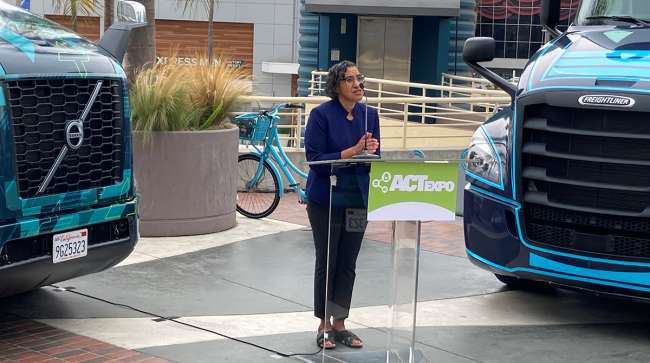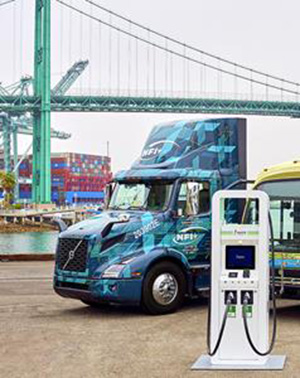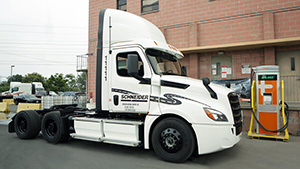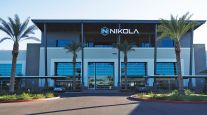Senior Reporter
Largest Electric Truck Deployment Ever Gets Going in Southern California

[Stay on top of transportation news: Get TTNews in your inbox.]
LONG BEACH, Calif. — The largest commercial deployment of battery-electric trucks in North America is ramping up in Southern California for an eight-year run, state officials announced Aug. 31 during the Advanced Clean Transportation Expo here.
Two of the largest U.S. fleets, Schneider and NFI, are participating. First steps toward the construction of vital charging infrastructure are taking place. Warehouse upgrades, on-site energy storage and rooftop solar are expected to generate $16.8 million in regional economic activity from construction cost.
One hundred heavy-duty trucks — 80 from Daimler Trucks North America and 20 from Volvo Trucks North America — will be delivered beginning next year and into 2023. They will operate in drayage and regional-haul applications.
At #ACTExpo, Electrify America & NFI announced a major investment in heavy-duty #electrictruck charging infrastructure for NFI’s fleet of Class 8 electric trucks serving @portoflongbeach, @PortofLA. Watch video https://t.co/ByCekdcMpp or read https://t.co/K0twzOp8tB@ElectrifyAm — Advanced Clean Tech News / ACT Expo (@ACTExpo) September 1, 2021
The project is known as Joint Electric Truck Scaling Initiative. The 100 electric trucks will displace 5.5 million DGEs (diesel gallon equivalents) of diesel fuel as they carry freight.
The California Air Resources Board and the California Energy Commission, together, put in $26.98 million.
The South Coast Air Quality Management District added $5.43 million.
Additional project partners added another $41.37 million.
More than 20 partners representing charging equipment manufacturers, infrastructure providers, nonprofit organizations, technology suppliers and others will collaborate on the lengthy project to ensure all aspects of fleet electrification are considered, the agencies explained.
Green Bay, Wis.-based Schneider will operate 50 eCascadia models from DTNA.
They will travel between the Port of Los Angeles and the Port of Long Beach and Schneider’s inland South El Monte facility.

Electrify America’s ultra-fast DC charger for NFI’s heavy-duty Class 8 trucks at the Port of Los Angeles. (Electrify America)
NFI will use 30 eCascadia models and 20 Volvo VNR Electric models. They will travel between the two ports and NFI’s inland Ontario facility.
The 50 battery-electric trucks at NFI’s Ontario facility will constitute the first 100% zero-emission logistics fleet in the state, the agencies noted.
“We will be taking delivery of production trucks between April 2022 and the second quarter of 2023,” Bill Bliem, senior vice president of fleet services at NFI, told Transport Topics. The company is based in Camden, N.J.
There will also be 1 megawatt in solar power and 5 megawatt hours of battery storage at NFI’s Ontario facility.
“It’s exciting stuff,” Bliem said.
Schneider is on the same delivery schedule, Rob Reich, chief administrative officer at Schneider, told TT.

Beginning in 2022, Schneider will add 50 Freightliner eCascadias to its Southern California intermodal operations. (Schneider)
He was asked why announce the project now.
“The infrastructure work takes awhile,” he said. “So really, the actual work on the project begins soon. To get the plan in place, the design of the facility in place and actually start breaking ground, now is the time to start to have it ready for the trucks.”
Earlier tests with one eCascadia showed Schneider just how complicated figuring out the charging is. It was a key lesson, he said.
“This is a very big deal,” he added, and noted state funding really drives this because it is expensive to get this started.
Separately, Schneider has set for itself some aggressive sustainability targets. “One of the most important is lowering our CO2 emissions per mile by 60% by 2035,” Reich said. “We know battery-electric and zero-emissions vehicles are a really important part of our ability to achieve that mission.”
Its 2025 goal is to have a 7.5% reduction in emissions, he said. “Part of that will be continued diesel improvement. We see that.”
Schneider ranks No. 7 on the Transport Topics Top 100 list of the largest for-hire carriers in North America.
Big news today! Schneider to become one of the largest battery-electric truck fleets in North America with the deployment of 50 Freightliner eCascadias. Read about how these trucks are a key component of our goal to reduce carbon emissions. >> https://t.co/rNfcXPcHky — Schneider (@WeAreSchneider) August 31, 2021
NFI ranks No. 16 on the TT for-hire 100.
The project is poised to reduce 5 tons of pollutants such as nitrogen oxides and particulate matter annually along Southern California’s I-710 corridor, as well as eliminate 8,247 metric tons of greenhouse gas emissions, the agencies reported.
Connecting the San Pedro Bay Port complex to inland distribution centers and warehouses, I-710 sees more than twice the average Los Angeles freeway truck traffic and accounts for 20% of all PM emissions in Southern California, according to the release announcing the project.
“Projects like JETSI are needed to help accelerate the large-scale manufacturing of zero-emission trucks,” CARB Chair Liane Randolph said. “They also demonstrate to other fleet operators how zero-emission technologies are commercially competitive, especially when it comes to cost savings on fuel and maintenance.”
Want more news? Listen to today's daily briefing below or go here for more info:




